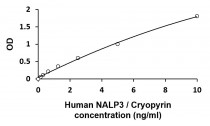ARG82259
Human NALP3 / Cryopyrin ELISA Kit
Human NALP3 / Cryopyrin ELISA Kit for ELISA and Human
Overview
| Product Description | ARG82259 Human NALP3 / Cryopyrin ELISA Kit is an Enzyme Immunoassay kit for the quantification of Human NALP3 / Cryopyrin ELISA Kit in serum, plasma and cell culture supernatants. |
|---|---|
| Tested Reactivity | Hu |
| Tested Application | ELISA |
| Target Name | NALP3 / Cryopyrin |
| Conjugation | HRP |
| Conjugation Note | Read at 450 nm. |
| Sensitivity | 0.078 ng/ml |
| Sample Type | Serum, plasma and cell culture supernatants. |
| Standard Range | 0.156 - 10 ng/ml |
| Sample Volume | 100 µl |
| Precision | Intra-Assay CV: 6% Inter-Assay CV: 9% |
| Alternate Names | MWS; FCAS; CLR1.1; CIAS1; FCU; AGTAVPRL; C1orf7; Caterpiller protein 1.1; PYRIN-containing APAF1-like protein 1; AVP; Angiotensin/vasopressin receptor AII/AVP-like; Cold autoinflammatory syndrome 1 protein; NALP3; AII; FCAS1; NACHT, LRR and PYD domains-containing protein 3; Cryopyrin; PYPAF1 |
Application Instructions
| Assay Time | ~ 3 hours |
|---|
Properties
| Form | 96 well |
|---|---|
| Storage Instruction | Store the kit at 2-8°C. Keep microplate wells sealed in a dry bag with desiccants. Do not expose test reagents to heat, sun or strong light during storage and usage. Please refer to the product user manual for detail temperatures of the components. |
| Note | For laboratory research only, not for drug, diagnostic or other use. |
Bioinformation
| Database Links |
Swiss-port # Q96P20 Human NACHT, LRR and PYD domains-containing protein 3 |
|---|---|
| Gene Symbol | NLRP3 |
| Gene Full Name | NLR family, pyrin domain containing 3 |
| Background | NALP3 gene encodes a pyrin-like protein containing a pyrin domain, a nucleotide-binding site (NBS) domain, and a leucine-rich repeat (LRR) motif. This protein interacts with the apoptosis-associated speck-like protein PYCARD/ASC, which contains a caspase recruitment domain, and is a member of the NALP3 inflammasome complex. This complex functions as an upstream activator of NF-kappaB signaling, and it plays a role in the regulation of inflammation, the immune response, and apoptosis. Mutations in this gene are associated with familial cold autoinflammatory syndrome (FCAS), Muckle-Wells syndrome (MWS), chronic infantile neurological cutaneous and articular (CINCA) syndrome, and neonatal-onset multisystem inflammatory disease (NOMID). Multiple alternatively spliced transcript variants encoding distinct isoforms have been identified for this gene. Alternative 5' UTR structures are suggested by available data; however, insufficient evidence is available to determine if all of the represented 5' UTR splice patterns are biologically valid. [provided by RefSeq, Oct 2008] |
| Function | NALP3: As the sensor component of the NLRP3 inflammasome, plays a crucial role in innate immunity and inflammation. In response to pathogens and other damage-associated signals, initiates the formation of the inflammasome polymeric complex, made of NLRP3, PYCARD and CASP1 (and possibly CASP4 and CASP5). Recruitment of proCASP1 to the inflammasome promotes its activation and CASP1-catalyzed IL1B and IL18 maturation and secretion in the extracellular milieu (PubMed:28847925). Activation of NLRP3 inflammasome is also required for HMGB1 secretion (PubMed:22801494). The active cytokines and HMGB1 stimulate inflammatory responses. Inflammasomes can also induce pyroptosis, an inflammatory form of programmed cell death. Under resting conditions, NLRP3 is autoinhibited. NLRP3 activation stimuli include extracellular ATP, reactive oxygen species, K(+) efflux, crystals of monosodium urate or cholesterol, amyloid-beta fibers, environmental or industrial particles and nanoparticles, cytosolic dsRNA, etc. However, it is unclear what constitutes the direct NLRP3 activator. Activation in presence of cytosolic dsRNA is mediated by DHX33 (PubMed:23871209). Independently of inflammasome activation, regulates the differentiation of T helper 2 (Th2) cells and has a role in Th2 cell-dependent asthma and tumor growth. During Th2 differentiation, required for optimal IRF4 binding to IL4 promoter and for IRF4-dependent IL4 transcription. Binds to the consensus DNA sequence 5'-GRRGGNRGAG-3'. May also participate in the transcription of IL5, IL13, GATA3, CCR3, CCR4 and MAF. [UniProt] |
| Cellular Localization | Cytoplasm, cytosol. Inflammasome. Endoplasmic reticulum. Secreted. Nucleus. In the Th2 subset of CD4(+) helper T-cells, mainly located in the nucleus. Nuclear localization depends upon KPNA2. In the Th1 subset of CD4(+) helper T-cells, mainly cytoplasmic. [UniProt] |
| Highlight | Related products: NALP3 antibodies; NALP3 ELISA Kits; NALP3 Duos / Panels; Related news: Exploring Antiviral Immune Response RIP1 activation and pathogenesis of NASH New ELISA data calculation tool: Simplify the ELISA analysis by GainData |
| PTM | The disulfide bond in the pyrin domain might play a role in reactive oxygen species-mediated activation. Ubiquitinated; undergoes both 'Lys-48'- and 'Lys-63'-linked polyubiquitination. Ubiquitination does not lead to degradation, but inhibits inflammasome activation (By similarity). Deubiquitination is catalyzed by BRCC3 and associated with NLRP3 activation and inflammasome assembly. This process can be induced by the activation of Toll-like receptors (by LPS), through a non-transcriptional pathway dependent on the mitochondrial production of reactive oxygen species, and by ATP. [UniProt] |
Images (1) Click the Picture to Zoom In
| Title | Download Link |
|---|---|
| ARG82259 Human NALP3 / Cryopyrin ELISA Kit User manual |
 Download Download
|






